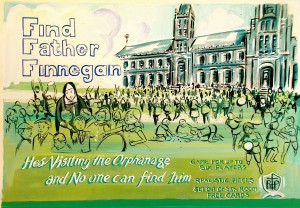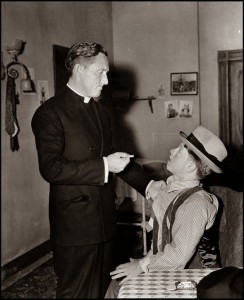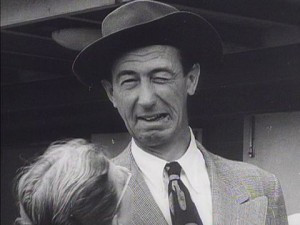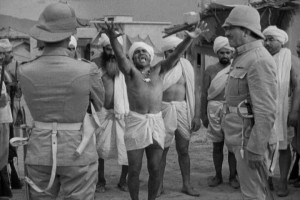Dear reader not much happening on the plebiscite front, but the knowledege that it’ll cost quite a bit of money and muddy a sensible public debate, whilst contributing to the mean lowest common denominator. Still the Attorney General Mr George, (another ambitious little Queenslander) Brandis, says it’s just the best thing, and you’d better believe it. Rupert agrees, so we’re in line, (so to speak). To keep your restive spirit attuned we offer you another snippet of games that almost made it.
Finding Father Finnegan, ‘He’s visiting the orphanage, and no one can find him’ Release date 1946.
Father Finnegan was released as a very popular adaptation of the father O’Malley game in which Big Crosby played the part of a parish priest in ‘The Bells of St Mary’s’. The archdiocese of Melbourne and Sydney liked the idea, and thought they’d nuance the plot structure about a young priest and his unruly charges shouldering the threat of imminent school closure, with a more localised version appropriate to Australian audiences. They proposed to make a film based loosely on the Bing Crosby story, but with Chips Rafferty as the lead , and Roy Rene as the rector in Cinesound’s, “ Father Finnegan visits the Orphanage’.
The Ken G Hall production, facing severe post war austerity measures to film and local cultural product were heartened to be given permission by the Federal government to be allowed access to the entire complement of the passenger ship SS Clysthenes, then brimming full with a boat load of post war British child migrants. The children were sourced from places as diverse as Liverpool, Nottingham, Manchester, Glasgow, Newcastle and Sheffield. Referred to colloquially as the ‘Snottingham Express’. The vessel landed at Port Melbourne in late May 1946, and the children were billeted in ex us army service tents on the grounds of Royal Park. Rather than utilise a current orphanage, which were full as a consequence of the mass celebration of U.S personnel after VE day the children were instructed by Hall and his crew, with the promise of regular baths and soggy peas to build a life-size cardboard and ply orphanage. It stood just shy of the tram terminus end of The Royal Melbourne Zoo.
During filming several children were lost to Lions, when the structure toppled during a fierce winter storm and others succumbed to whooping cough, spondilitis and terminal whingeing. Unexpectedly their conditions deteriorated with exposure to healthy diet and sunlight. Sadly the film, half completed was shelved in 1947, as the children became re deployed as farm help and factory hands for post war industry. The semi completed film was then re-directed by the indian director, Shiva Rhammituppaboy and became a overnight sensation in the Madras 47 Separation film festival. Unfortunately in rioting post independence, a record twenty five thousand Indians of Pakistani descent were immolated in a fire at the Empire Sunset Theatre. (recommended seating capacity 300) . The fire it was rumoured started due to the mistaken belief that pig fat had been used as a seal and lubricant in individual film canisters. However forensics revealed that the unstable acetate ignited as a consequence of the hand tinting of frames made of the australian filmed scenes to ensure the Chips looked darkened. This was to establish a visual continuity for the local actor, Depak Chopperty, or as was reported in cinema papers (Cahiers du Cinema 1V 1948) ‘when Chips became Chops’.
Finding Father Finnegan is a game of detective work. It consists of a board, a father counter, players counters, clues cards, clue pieces a clock and a spinning arrow. The players are entrusted to find the father who is hiding in the institution. One player is the father but pretends he’s one of the ‘finders’. Whilst the players wait for their turn, they must cover their eyes with a copy of the Old testament (which are supplied). Each turn they play there are new clues, though not all of them lead to Father Finnegan. Reputedly the game was similar to Cluedo, but with one distinct difference. If the Father Finnegan is found in a short space of time quickly the children are safe, if prolonged searching the children disappear, and can not be found. And father, rather than being ‘found’ is just moved on.
This game was a great favourite, but production discontinued in 1958, when the transmigration scheme ceased. In all over 150 thousand were produced, and some can still be at the Catholic Education Office, and in isolated instances in the archdiocese of Ballaarat, where it is still played today. The game board was of the simple fold type with of a plan of the orphanage, numerous sick rooms, a chapel and holes for hiding priests and children in. In addition to the previously described game pieces and Father Flannery, each board held at least a hundred children as little brown discs, and four bibles, a piece of rope and a long piece of rubber tube and a blindfold. The game was activated by an arrow on a spigot, and each move would examine another part of the orphanage. Game counters included nuns, in which each player could block a thorough investigation and the player opposite would go back to one.
A criticism of the game is that it took hours and hours to find Father Flannery, was impossible for the children to ever win, and the nuns, were often broken as they were made of cheap cardboard, and had a habit of flying of the board if a wind was put up them. The children game counters little bakelite discs, were magnetised, so they could not move, unless instructed, A first for locally produced games technology.




Pingback: Poetry Sunday 2 October 2016 | pcbycp